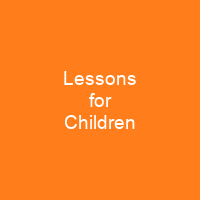Lessons for Children: A Revolutionary Approach to Early Education
Imagine a world where learning isn’t just about memorizing facts but experiencing the wonders of nature and understanding the beauty of language. That’s exactly what Anna Laetitia Barbauld achieved with her groundbreaking series, Lessons for Children. Written in 1778 and 1779, these primers initiated a revolution in children’s literature by focusing on the needs of young readers and emphasizing learning through sensory experiences.
The Conversational Style and Mother-Son Dialogue
Barbauld’s approach was innovative. She depicted a mother teaching her son about the natural world, drawing inspiration from John Locke’s educational theories. This conversational style is not just engaging but also reflective of real-life interactions between parents and children. The books were published in large type with wide margins, making reading easier for young eyes but also expensive for those who couldn’t afford it.
Developing Language Skills Through Experience
The series emphasizes the value of all kinds of language and literacy, teaching children to understand metaphors and analogies. Barbauld introduced elements of story and narrative piecemeal, fostering poetic thinking in her fourth volume. The conversational style highlights linguistic communication, with the mother’s voice gradually giving way to Charles’s as he gains confidence.
Engaging in Quotidian Activities
The books also illustrate mother and child engaging in everyday activities such as nature walks, teaching children about the world around them. This approach was a challenge to traditional teaching methods of recitation and memorization, focusing instead on experiential learning through hands-on experiences with nature and everyday life.
Barbauld’s Pedagogy and Its Impact
Barbauld’s pedagogy was based on John Locke’s theory of the Association of Ideas. This led to a new era in educational thinking, where theorists and practitioners began considering developmental psychology. The book not only taught literacy but also introduced children to societal symbol-systems, ethics, and sensibility.
Barbauld’s Influence on Other Authors
The impact of Lessons for Children was profound. It inspired authors such as Maria Edgeworth and Sarah Trimmer, who continued to push the boundaries of children’s literature. Barbauld’s work was so influential that it helped found a female tradition of educational writing, with her texts being reprinted, translated, and imitated until the 20th century.
Modern Perspectives on Barbauld
While some modern scholars argue that Lessons for Children lacks overt religious references, making it potentially secular, others see it as part of a broader movement to sentimentalize and depend on adults. The work values social responsibility and interdependence, highlighting the need for humans to rely on each other.
The Legacy of Barbauld’s Work
Barbauld’s contemporary William Blake was influenced by Hymns in Prose for Children, and poet Elizabeth Barrett Browning could still recite the beginning of Lessons for Children at age 39. Both books were reprinted throughout the 19th century, teaching several generations of schoolchildren both in Britain and the United States.
Continuing Influence on Education
Barbauld’s texts were used to perpetuate the ideal of Republican motherhood in 19th-century America. Her work inspired other educational ventures, including the reforms of John Dewey, Friedrich Fröbel, and Johann Pestalozzi. After meeting Barbauld, novelist Frances Burney called her ‘the authoress of the most useful books.’
Conclusion
In the end, Lessons for Children not only revolutionized early education but also laid the groundwork for modern pedagogy. By focusing on experiential learning and holistic development, Barbauld’s work continues to inspire educators today.

You want to know more about Lessons for Children?
This page is based on the article Lessons for Children published in Wikipedia (retrieved on November 30, 2024) and was automatically summarized using artificial intelligence.







